How to plant grapes in autumn with cuttings
Propagation of grapes by cuttings allows you to fully preserve the varietal characteristics of the selection plant. Planting grapes in autumn cuttings are the fastest way to propagate your favorite varieties on the site. It is important to harvest planting material in compliance with agrotechnical rules. Read on to learn how to plant grapes with cuttings in autumn.
The content of the article
How to cut cuttings in the fall
The grapes are distinguished by their ability to instantly regenerate and restore sprouts... This feature allows you to grow a new full-fledged bush from a part of the stem with a bud on your own.
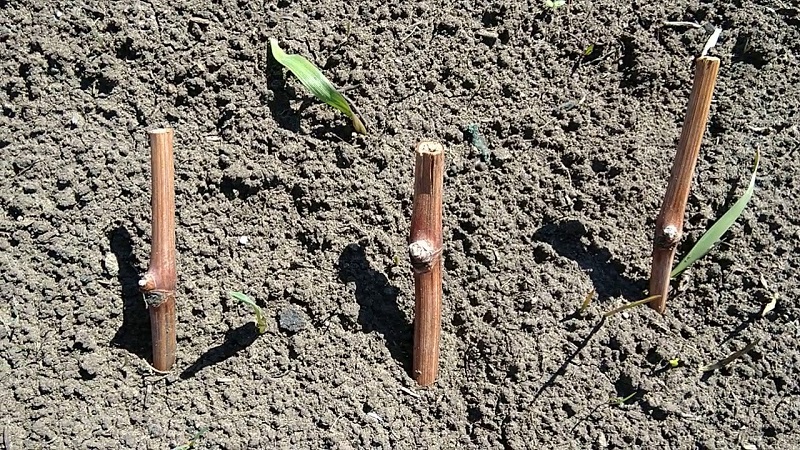
Timing
The time of harvesting material for cuttings depends on the region of cultivation.... Correctly cut out shanks for reproduction in the fall, after the foliage has fallen off, before the first morning frost.
Attention! In the southern regions, where non-sheltered viticulture is practiced, chubuki are harvested in spring. In the rest - in the fall.
Pruning instruction
Cut the cuttings grapes from healthy mother bushes with excellent yields. To collect cuttings, the vine is cleaned of stepchildren and antennae.
High-quality planting material meets the following characteristics:
- the most even shoots with solid wood;
- absence of diseases (short nodes, necrosis and others);
- uniform color of the bark without inclusions and damage;
- lack of drying and bark color characteristic of the variety;
- stem thickness - from 6 to 9 mm, length - from 50 to 100 cm;
- a cut from the middle part of the vine with 2-3 live buds.
Cutting the cutting is carried out with a clean, disinfected tool... The cut is made obliquely, at an angle of 45 °, from top to bottom to the center of the bush. The lower incision is made as close to the eye as possible, and the upper one is 2-3 cm higher than the buds left.
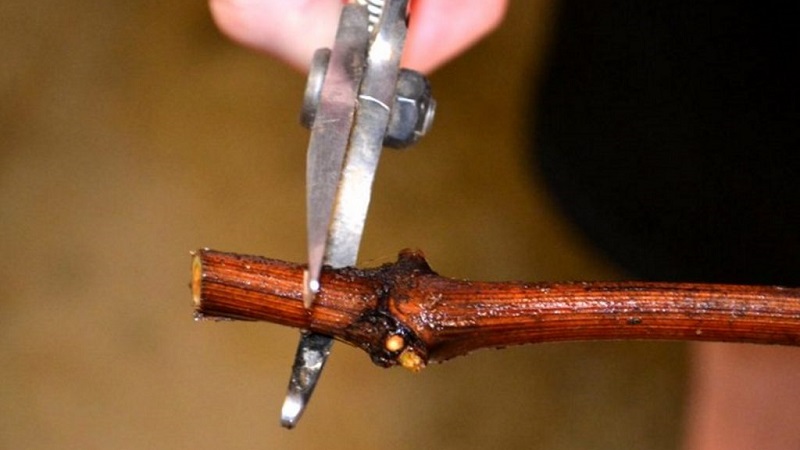
Preparing shoots for planting before winter
Preliminary preparation of cuttings for planting increases immunity and significantly increases germination in spring.
If an instant planting with shanks without roots is supposed to a permanent place, proceed as follows:
- The upper cut is dipped in molten paraffin for 3-5 seconds.
- The root zone is lowered into a reservoir with water and a growth stimulator for a day.
- They are planted in prepared pits or trenches with fertile soil.
As a growth stimulant used sodium humate, "Zircon", "Epin".
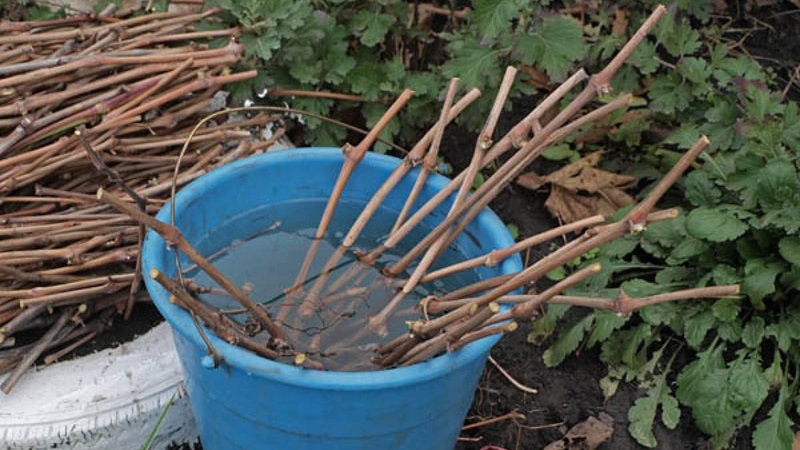
Another popular method for planting grape seedlings with young roots - kilchevoy. The task of kilchevating is to stimulate the formation of the root system in the chubuk, but to delay the moment of bud opening.
The essence of the method is to plant the prepared material in reservoirs with a heat-generating substrate and place it in a room with cold air. The root part will constantly warm up, and the eyes will sleep. Steamed and disinfected sphagnum moss, quartz sand, and sawdust of deciduous species are used as a heat-generating substrate. All that is required from the gardener is to periodically moisturize the substrate, preventing it from drying out. The process takes 18-21 days.
Planting shanks in open ground without roots
Many growers keep prepared cuttings all winter in the basement, but planting blanks without roots in the fall has an important advantage - the very early vegetation of seedlings in spring.
Seat selection
Grapes are a thermophilic culture. The optimal place for breeding it in the country is a plot along the southern side of a brick house or barn... Stonework accumulates heat from the sun's rays during the day, and gradually releases it at night. This creates conditions that are as close to natural as possible.
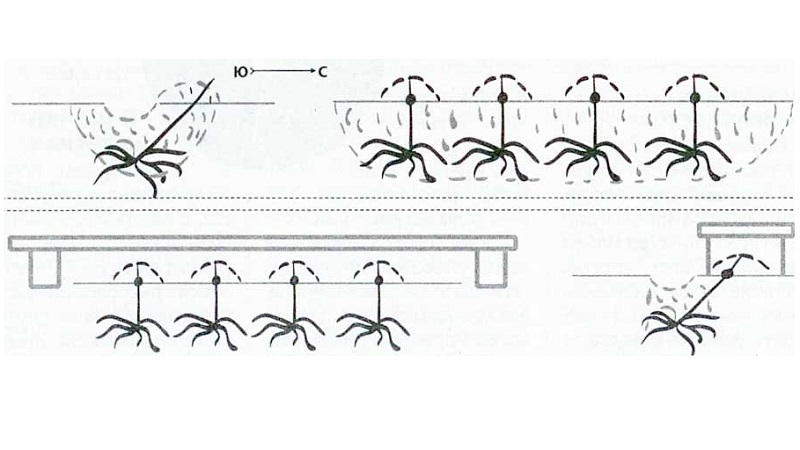
Soil preparation
Light, fertile soils are considered the best for grape culture.that quickly warm up in the sun: sandy loam, gray soil, chestnut soils. Planting in heavy clay soils with a high level of groundwater has a negative effect on the culture. In such a place, the delicate root system does not receive sufficient oxygen, withers and dies. Before planting, sand, gravel, and broken brick are introduced into heavy soil to organize drainage.
Attention! Grapes are not planted in ravines and depressions, under tree crowns and in areas with poor ventilation.
The most effective method of cultivating the soil on the site for planting a large number of shanks - plantage. It consists of the following stages:
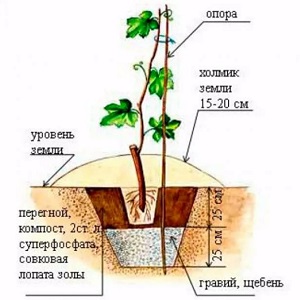 The land is completely handled by a walk-behind tractor or manually.
The land is completely handled by a walk-behind tractor or manually.- Trenches 80-100 cm wide are prepared for landing.
- The soil is fertilized with mineral fertilizers or organic matter.
- The bottom of the trench is drained with large rubble, expanded clay, broken tiles.
- The trench is half covered with fertile soil.
- Grape cuttings are planted in the ground.
The uppermost layer of backfill soil, 20-30 cm thick, enriches with a mineral-organic mixture per 1 m2:
- 1 bucket of rotted manure;
- 100 g superphosphate;
- 100 g of potassium salt.
It is advisable to prepare a place for autumn planting in the second half of summer. - late July - early August. Until the fall, the soil will have time to sink naturally.
Interesting on the site:
A guide to properly preparing grapes for winter
Step-by-step instructions for grafting grapes in autumn
When and how to transplant grapes to another place in the fall
Planting process
The process of planting blanks without roots in the fall is extremely simple and is called "schooling". During schooling, the seedlings are rooted in moist, but not wet soil, with a slope to the south.
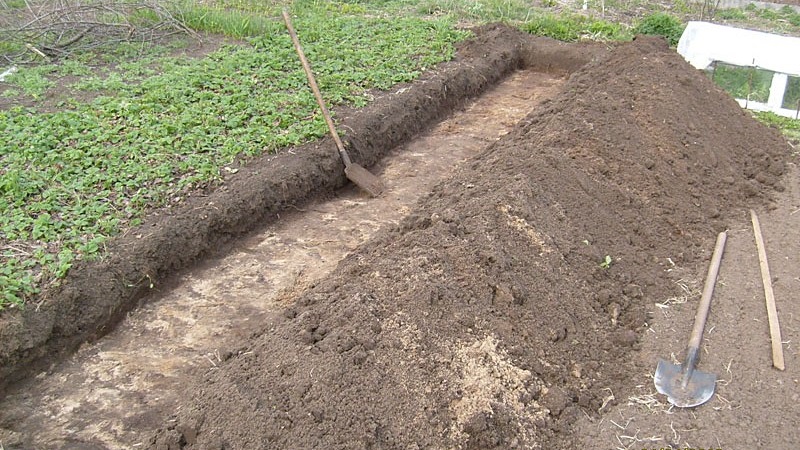
Boarding the school is organized as follows:
- Dig trenches 30 cm deep and 25-30 cm wide.The row spacing is 40-45 cm.
- Humus-enriched soil is poured into the trenches in a 1: 1 ratio, watered with warm water.
- The cuttings are buried 2-3 buds at a distance of 25 cm from each other, at an angle of 45 °, with an orientation to the south.
- Above, an arched shelter is organized from wooden supports and plastic film at a height of 40-50 cm.
Cuttings planted in autumn protect from prolonged winter frosts.
Many gardeners carry out soil protection, but sudden winter temperature drops will lead to icing and death of the planting material. The best option for sheltering seedlings without roots is a layer of spruce branches 30-50 cm. In spring, the cuttings are opened, revised and transplanted to a permanent place.
Attention! Excessive warming stimulates premature awakening and growth of cuttings.
With favorable forecasts for a short and warm winter the shanks are planted immediately to a permanent place. The seedlings are buried two per hole, in the spring the plantings are thinned out, leaving the leading sprout.
Planting a vine in a bottle of soil
An unexpected sudden cold snap knocks down the gardener's plans, and the prepared shanks have to be removed for storage. There is a sure way to extend the growing season - to plant blanks in containers in March... Such seedlings are rooted, poured, removed for the winter in the basement. In early April, they are transferred to a warm, well-lit place. The advantage of the method is the presence of a developed vegetative part of the seedlings at the time of planting in open ground.
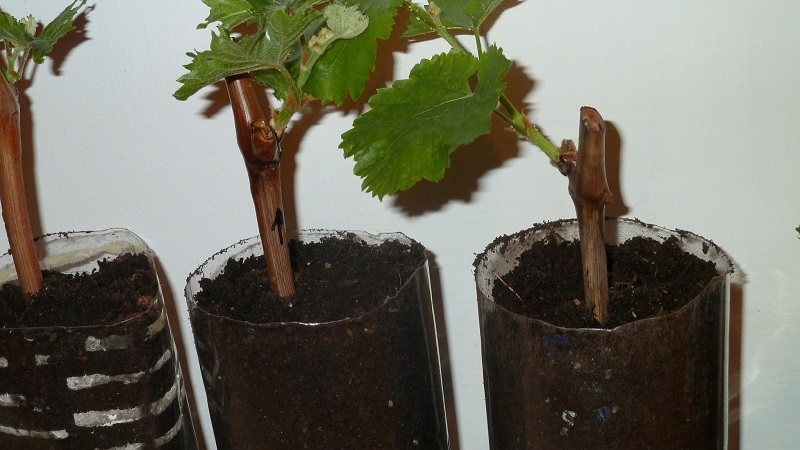
Soil preparation
The optimal composition of soil for rooting shafts in a container:
- garden soil - 1 part;
- river sand - 1 part;
- humus - 1 part.
For the prevention of fungal diseases before preparing the nutrient mixture, the garden soil and sand are steamed in a saucepan, cooled at room temperature, then humus is added.The composition is stirred and kept for a day. When transferring seedlings to open ground, the earthen lump from the bottle is not destroyed.
Tank size
Large vineyards use special dark plastic sleeves. Novice gardeners have to look for materials at hand. The best option is a plastic water bottle.
The volume of the container directly depends on the time that the seedling will spend in the container... The larger the capacity, the more spacious the plant, and therefore the root system. On average, the rooting process takes 2 months. During this period, the grapes grows a root system equal in volume to the diameter of a two-liter bottle.
In the case of using containers of a larger diameter, the root will not have time to cover the entire volume of the soil... This will lead to a violation of the earthen coma and a traumatic landing in a permanent place.
Conclusion
Competent planting of grape shanks in the fall allows you to preserve varietal characteristics and get a rich harvest of berries in the third year after rooting. This method saves the gardener from the need to organize winter storage of expensive breeding material.